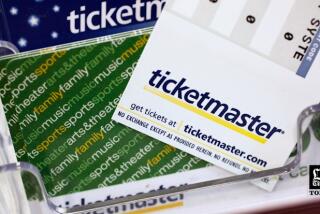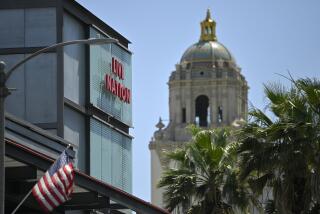TRAVEL INSIDER : Airline Antitrust Suit Won’t Yield Windfall : Settlement: Consumers who qualify for a refund can expect vouchers for domestic flights rather than cash.
- Share via
About 10 million airline passengers received a claim form in the mail last month, telling them how to file for a partial refund for certain ticket purchases made in the past five years. At first sight, the seven-page document seems complicated, but don’t be intimidated. For most recipients, filling out and submitting the form is easy, and the reward could be at least a small savings on future air travel.
The refund is the result of an antitrust settlement reached June 22 with nine major U.S. airlines in a class-action suit in U.S. District Court in Atlanta. The suit alleges illegal price fixing on the part of the carriers, and while none admits wrongdoing, they have offered a total of $458 million in cash and vouchers to passengers to end the legal action.
To qualify for a refund, you must have purchased a domestic ticket on one or more of the airlines between Jan. 1, 1988, and June 30, 1992, and you must have flown on a flight into, out of or through 34 specified hub airports. If you think you are eligible for a refund but have not received a claim form in the mail, you can request one in writing.
But don’t expect a financial windfall. Most claim applicants--and especially leisure travelers--will receive vouchers rather than cash, and the vouchers will be valued at no more than $100-$250, depending on the number of airline passengers who submit claims. The more people who want to share the pot, the less each will receive.
How many are expected to file? “There’s really no way to estimate,” says Randy Jones, spokeswoman for the Atlanta law firm of Carr, Tabb & Pope, which is serving as liaison counsel for the airline ticket purchasers who initiated the suit in 1990. My own informal survey indicates many people who did not receive a claim form plan to request one and file for a refund. The filing deadline is Feb. 15, 1993, and there is no special benefit in filing early.
In addition, a limiting provision of the settlement somewhat reduces the value of the vouchers. They are valid only for the purchase of domestic round-trip tickets, and no more than 10% of the fare can be paid for with a voucher. For example, a passenger purchasing a $250 round-trip ticket can use a voucher amounting only to $25. With $100 in vouchers, you would have to buy four round-trip tickets at $250 each, two tickets at $500 each or one ticket at $1,000.
The vouchers are expected to be distributed in mid- to late 1993, but the timing is subject to court approval. Also, the volume of claims may affect the timeliness of the processing.
The airlines involved in the suit are American, Continental, Delta, Midway, Northwest, Pan Am, TWA, United and USAir. Any vouchers received from the settlement can be used interchangeably to purchase tickets on any of the airlines except Northwest. Only Northwest vouchers will be accepted for Northwest tickets. Pan Am and Midway have gone out of business, but past flights on these carriers can be cited to make a claim.
Qualifying flights must have begun, passed through or ended at these city hubs: Atlanta, Baltimore, Boston, Charlotte, Chicago (O’Hare or Midway airports), Cincinnati, Cleveland, Dallas-Ft. Worth, Dayton, Denver, Detroit, Houston, Indianapolis, Kansas City, Los Angeles, Memphis, Miami, Minneapolis-St. Paul, Nashville, Newark, New York (John F. Kennedy or La Guardia), Orlando, Philadelphia, Pittsburgh, Raleigh-Durham, Salt Lake City, San Francisco, San Jose, St. Louis, Syracuse and Washington (National or Dulles).
The vouchers issued by all but Northwest are redeemable for up to 36 months after they are mailed out. Northwest’s vouchers are redeemable only for 24 months. Claimants living in areas served by Northwest can specify that they want the carrier’s vouchers.
To request a claim form, send a post card or letter with name and address to Airline Antitrust Litigation, P.O. Box 267, Pennsauken, N.J. 08110-0267.
The settlement, which has not yet received court approval, is being sharply criticized by the American Society of Travel Agents (ASTA), based in Alexandria, Va. “I would characterize it as settling with a wooden nickel,” says Burton Rubin, the general counsel. A court hearing on the fairness of the settlement is scheduled for Oct. 19 in Atlanta, and the organization plans to challenge some of the provisions. A ruling is expected to follow within a week.
Rubin’s group is particularly upset at a requirement that vouchers must be redeemed for tickets only with the airlines directly and not through travel agencies. Currently, about 80% of the airline tickets sold in this country are handled by travel agents. But unless the settlement is changed to allow agencies to accept vouchers, the agencies fear they will lose a substantial chunk of business.
As for travelers themselves, says Rubin, those people who normally buy tickets through a neighborhood travel agency will be inconvenienced because they will have to go to an airport or city ticket office to use the vouchers. In addition, travel agents routinely check fares on several airlines to see which is offering the lowest price. Travelers using vouchers will have to do the legwork themselves.
In Rubin’s view, the exclusion of travel agents also substantially reduces the impact of the settlement on the airlines. Normally, the carriers pay travel agents a 10% commission on every ticket an agent sells. Since agents won’t be permitted to handle voucher-paid tickets under current settlement terms, the airlines can keep the commission. And since the airlines will accept vouchers only for 10% of a ticket’s cost, the settlement, according to Rubin, really costs the airlines very little.
“That’s not much of a penalty,” he says.
In agreeing to settle, the airlines offered $408 million in vouchers to be used for future air travel and $50 million in cash. The cash is expected to pay lawyers’ fees and administrative costs, as monitored by the court.
Although the bulky airline claim form looks as daunting as anything created by the Internal Revenue Service, it is actually rather easy to understand and complete.
Most travelers will be able to request a refund without having to provide old ticket stubs or other receipts. However, frequent travelers--those who have paid for more than 10 qualifying round-trip tickets in the past five years--may have problems digging for proof of purchase and other required documentation from old files.
The claim form gives eligible travelers three options in applying for a refund. In all cases, applicants must have purchased the tickets, whether for themselves or for family members. You cannot claim a refund on a ticket your employer bought for you; the employer must file a separate claim.
The options:
* Form A: This is the short form and the easiest to complete. Use it if you have purchased at least one qualifying round-trip ticket (but fewer than five) for a domestic flight. No documentation is required, but you must sign the form, and a false claim would subject you to a charge of perjury. Applicants using Form A can receive a maximum of $100 in vouchers, but the amount could be much less depending on the number of travelers making a claim. Each claimant will receive the same amount of refund, no matter how much the qualifying ticket originally cost.
* Form B: Use this option if you have purchased at least five qualifying round-trip tickets (or 10 one-way tickets). No documentation is required for this option either, but you must name the hub cities to, through or from which you flew. Again, you sign the form under penalty of perjury. Each applicant’s claim will be valued at $2,500, no matter what was paid for the five or more tickets. The maximum refund is 10% of the amount or $250 in vouchers, but you could get less.
* Form C: This form is designed for travelers who have purchased more than five qualifying round-trip tickets valued at more than $2,500 and have the ticket stubs or other documentation to prove it. Large business firms, in particular, are expected to use this form. The amount each applicant receives depends on how many claims are filed and for how much. The maximum refund is 10% of the total price of the tickets, but the amount actually may be less.
More to Read
Sign up for The Wild
We’ll help you find the best places to hike, bike and run, as well as the perfect silent spots for meditation and yoga.
You may occasionally receive promotional content from the Los Angeles Times.






